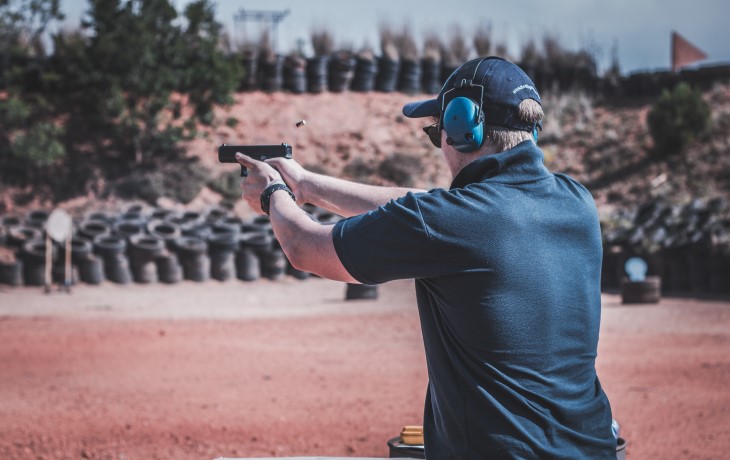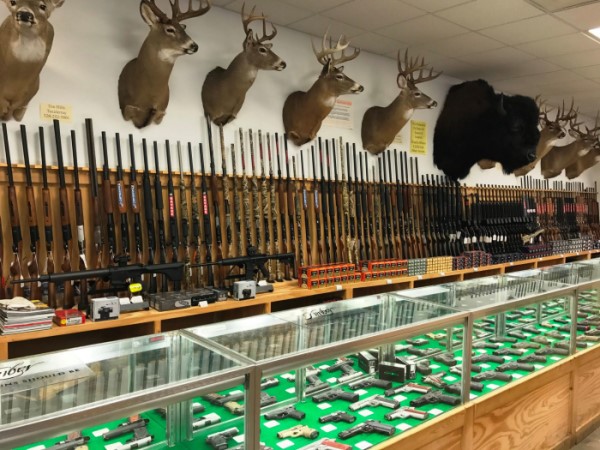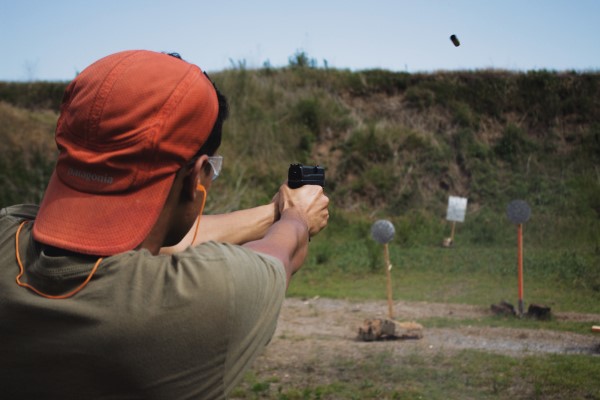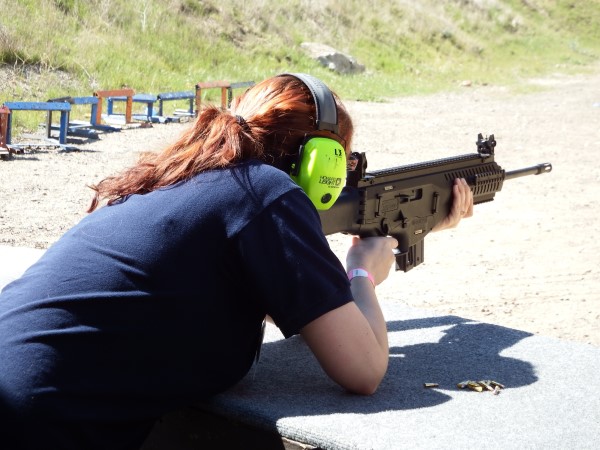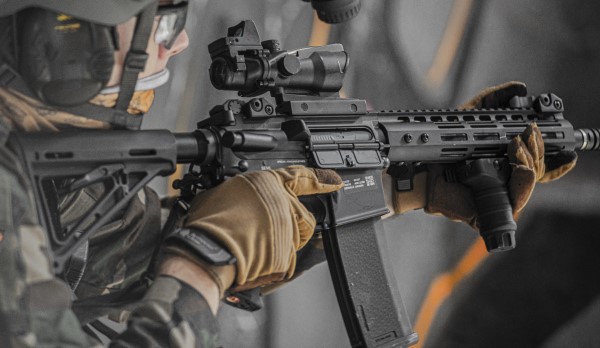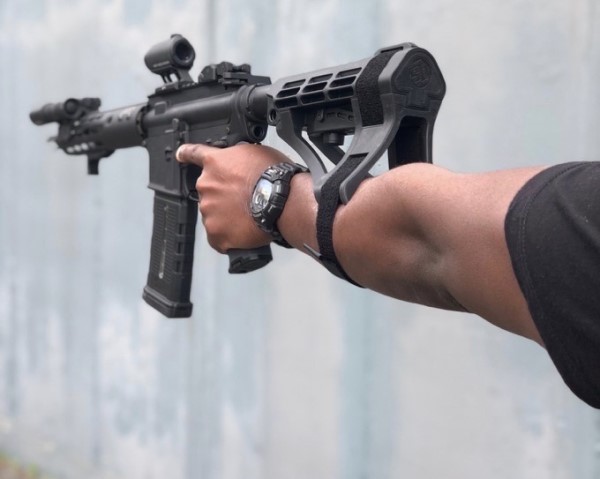Although it doesn’t really affect the overall answer as much as you might think, we do consider emergency preparedness needs in addition to general “what’s best for a beginner?” advice, since many people’s first gun will also be their only gun and thus does double duty as a prep.
If you’re not sure yet what terms like “caliber” or “magazine” mean, or why we stick with the most common calibers like 9mm and .223, check out the total newbie’s guide to guns.
The most important bits:
- The average first gun costs around $400-$800.
- Most people should buy either (or both) a 9mm pistol or .223 AR-15 rifle.
- If you forced us to pick one firearm for a generic beginner, it’d be an AR-15. They are the popular standard for a reason and make a great all-around weapon for prepping.
- Some people believe a shotgun is always the best choice because of an old wives’ tale about the “click-clack” racking sound scaring away threats. In reality, though, that’s more myth than real and shotguns aren’t as good as pistols or rifles for most people/situations.
- Pistols are generally cheaper than rifles and easier to carry or conceal.
- Rifles are more accurate and shoot longer distances.
- A pistol will be effective in the 0-25 yard range. Rifles are effective at 0-600+ yards.
- Stick with these calibers: 9mm, .223/5.56, .308/7.62, 12 gauge, 20 gauge, and .22 LR.
- Stick with magazine-fed semi-automatics for pistols and rifles. That means no revolver pistols or bolt-action rifles.
- Because of a confusing patchwork of laws in the United States, you’ll want to understand what’s prohibited where you live. Try Googling both “(your state) gun laws” and “(your city) gun laws” because sometimes they’re different (eg. Chicago and Illinois).
- The firearm market can get very complicated past these basics, such as rifles with a brace that legally become pistols, short barreled rifles, and so on. Stick with the basics until you’re experienced, if for no other reason than to avoid complicated gray areas in the law.
- Don’t forget training and proper storage! You are not a responsible gun owner or actually prepared unless you have proper training. Do not just buy a gun, throw it in a drawer or go-bag, and assume you’ll figure it out later — that’s dumb in more ways than we can count.
It’s impossible to pick one or two specific firearms that are the best for every beginner. Instead, it’s more helpful to say which types are the best, then give a few top choices within each category.
9mm pistols:
- Glock 19 (or the slightly-larger Glock 17)
- Heckler & Koch VP9
- Sig Sauer 320
- Smith and Wesson M&P 2.0
- Springfield XD(M) 9mm
.223 AR-15 style rifles:
- Bravo Company Recce 16
- Daniel Defense DDM4V7 PRO
- Ruger AR-556
- Sig Sauer M400 Tread
- Springfield Armory Saint
.308 AR-10 style rifles:
- Daniel Defense DD5 V4
- LaRue PredatAR 7.62
- Rise Armament 1121XR
- Springfield Armory Saint Victor
- Windham Weaponry R18 – 308
Most beginners should pick from one of these categories for prepping or self-defense. Some tips on narrowing down which category is right for you:
- The ordering above (9mm, AR-15, AR-10) reflects cheapest to most expensive, lightest to heaviest, easiest to carry/conceal to hardest, shortest-range to longest-range, and least ‘punchy’ to most punchy.
- If you want the option to carry a weapon out in public during normal life, pistols are the way to go for both on-body concealed carry (eg. attached to your belt or in a purse) or for storing in your vehicle.
- If you’re mostly thinking about home defense, pistols are fine, but we generally recommend smaller AR-15s because you’re more likely to hit your target (instead of a bystander) and the extra range means you can defend yourself from further away.
- If you’re mostly thinking about hunting, the .308 AR-10 style rifles are the best at taking down animals at long distances.
.22 LR pistols:
.22 LR rifles:
If you live in an area that heavily restricts or bans pistols and rifles, you could consider a shotgun, lever-action rifle, bolt-action rifle, or air rifle.If you live in a place like California that allows weapons like AR-15s as long as they are heavily modified/crippled, it’s still often better to stick with a crippled AR-15 than abandoning the idea of a common-style rifle altogether. Work with your local gun shop to buy a California-compliant AR-15.
Shotguns are legal in every part of the US. Some states, like New Jersey and Rhode Island, only allow firearm hunting with shotguns.
Some beginners have a movie-based perception that a shotgun blast spreads out really wide, to such an extreme that all you need to do is point it in the general direction and you’ll hit your target. Real life doesn’t work that way, even though the shot does spread out in a (limited) cone.
That makes shotguns good for hunting small game — it’s easier to hit a flying bird with a cone of smaller ‘bullets’ than a single larger one, for example. You can use a type of shotgun ammo called slugs that, instead of a cone, shoots one larger ‘bullet’. Slugs can make a shotgun somewhat effective at taking down larger game such as deer.
Best shotguns:
- Benelli Supernova
- Beretta A300 Outlander
- Mossberg 590 A1
- Remington 870 Express
- Winchester SXP Black Shadow
Bolt-action rifles are also legal in every US state. They’re almost always used for hunting and precision shooting — less so for defense — but if you’re heavily restricted by law and don’t want a shotgun:
Be prepared. Don’t be a victim.
Want more great content and giveaways? Sign up for The Prepared’s free newsletter and get the best prepping content straight to your inbox. 1-2 emails a month, 0% spam.
Why you can trust this
I’ve been a firearms instructor for four years, teaching a diverse range of students from total beginners to professional marksman and high-level industry personnel. Besides my day job as a researcher at The Prepared, I also own a successful firearm parts manufacturer and consulting company. My articles have been featured in The Firearm Blog, Guns America, Small Arms Review, Small Arms Defense Journal, and more. I have attended numerous armorer courses and have unique expertise in long-range shooting and the AR-15/M-16/Mk18/M4 family of weapons.
What to look for
A mix of general and preparedness criteria:
- Sweet spot of price and performance for a beginner. This tends to be $500-$1,000 for rifles, $400-600 for pistols, and $300-$600 for shotguns.
- Versatile. Is the firearm only good in certain uses (eg. long-range hunting) or can you use it across a wide range of scenarios?
- Common ammunition. If an emergency hits and you need more ammo, how easy is it to find? That’s why we stick to 9mm, .223, .308, 12ga, 20ga, and .22 LR.
- Common parts. If an emergency hits and your gun needs a replacement part, how easy is it to find?
- Easy to repair. Some gun designs are more complicated or rare than others. Whether repairing on your own or paying/asking someone for help, make the job easier by avoiding niche or difficult designs.
- Dependable. Some firearms are known to wear down more quickly. It’s not a problem in the design, just the nature of differences in physics between calibers. A .308 barrel will last for thousands of more shots than a 6.5 Creedmoor barrel, for example.
- Known track record. An emergency isn’t the time to depend on a brand or model without a solid track record. Stick with established options.
- Easy to learn. The more common a weapon (or weapon style), the easier it will be for you to find free training on the web and qualified local instructors.
- Ease of use for beginners. This is subjective and hard to define on paper, but experienced instructors know that some models are easier for beginners to get comfortable with than others, and we’ve baked that into these recommendations.
It’s tempting to get a super-cheap “beater” for your first gun. But it doesn’t cost much extra to cross over from “throwaway beater” to “good enough for prepping,” so don’t skimp too much unless you’re already confident you’ll end up buying more models later.
Vice versa, you don’t have to go “Gucci” and buy the most expensive models. It’s fine if you do. But the extra money you’re spending won’t make much of a difference in your shooting ability until you’ve gone through a bit of training/practice — ie. an extra $1,000 on your first rifle isn’t going to make you more accurate, since the vast majority of your beginner accuracy or performance problems will be due to skills, not gear.
Versatility matters a lot in prepping. If you only have one firearm, you want to feel capable in as many situations as possible: shooting targets near and far, being on the move, being in a fixed position, and so on.
A shotgun, for example, might do fine at home defense when everyone is in the same room, yet fall short if you’re inside the building defending against outside people.
Trying before buying
Some guns have more of a “love or hate” reaction once people actually hold and use them, while others tend to be more universally accepted. It will take a lot of shooting and trying different firearms for beginners to develop that feel.
So part of how experts chose the recommended guns in this guide was considering which models are more universal or one size fits all. You should feel confident buying any of the models in this review online, without having held them first.
That said, it never hurts to hold (and if possible, fire) a weapon before buying it. Especially if your hands are unusually large or small.
The holding part is easy. Just take your shortlist of candidates to a local gun store and ask to see them. Almost any gun store will have a Glock 19 or basic-pattern AR15, for example, and you can call ahead to ask.
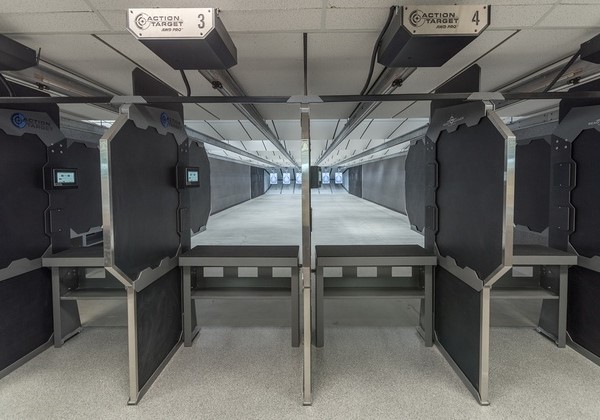
Firing before buying is harder. If you don’t have a friend with existing firearms, Google “gun rental (nearest city)” to find shooting ranges with rentals that are open to the public. If you’re going to go, it’s worth the extra money to try multiple guns. You’ll quickly get a feel for basic likes and dislikes.
Tip: If you’ve never shot before, don’t be embarrassed about saying so and asking for help. They want to help! Some of these gun ranges with rentals will also offer a short beginner lesson (for an extra fee), so you could hit two birds with one stone in the same trip.
Do you need more than one gun?
You’ll be fine if you only buy one, especially if you stick to the criteria or recommendations in this guide.
However, there’s a lot of value in having two because you can have one pistol and one rifle — that combo will cover almost any need you have and reduce the risk that one thing you buy becomes illegal in your area.
If you then got a third firearm and you’re mostly thinking about preparedness, a shotgun would complete the tripod.
Young? Old? Disabled? Weak? Jumpy? Think about physically holding and firing a weapon
Some new shooters struggle to hold up and fire certain kinds of weapons. The form factor of the weapon itself could be an issue (eg. a big heavy rifle vs. a compact rifle) and/or certain calibers can make the ‘bang’ harder to control.
Focusing on the ammo:
- Among the core ammo types to stick with, .22 LR (“twenty two long rifle”) is the weakest and thus easiest to shoot. The jolt, recoil, and sound are the closest thing to nonexistent in the gun world.
- Many parents teaching their minor children to shoot will start with .22 LR for these reasons.
- Adults who are freaked out about guns or are just generally skittish people may also want to start with a .22 LR.
- .22 LR is the only common ammo we consider that is used in both pistols and rifles.
- 9mm is the only other pistol ammo in this guide. Part of why it’s so common is that it’s the sweet spot between easiness and power.
- The FBI, for example, recently switched to 9mm for their pistols because they found that female, weaker, or less-trained agents handled it better than bigger calibers without any sacrifice in effectiveness.
- Among rifles, .223/5.56 is much easier to shoot than .308/7.62 because the latter packs more of a punch. You might shoot a magazine worth of .308 before getting a bruise on your shoulder from the buttstock, for example, while a .223 could take a few hundred rounds to bruise.
- Among shotguns, 20 gauge is easier to shoot than 12 gauge. (In pistols/rifles, bigger ammo caliber numbers mean bigger ammo. Shotguns are the opposite.)
Then there’s the weapon itself. Pistols are obviously the easiest: A pistol might only weigh two pounds vs. a rifle at eight pounds.
That might not seem like a big difference, but try to hold a few pounds in your hand with your arm extended out and parallel to the floor — at some point you’ll start to struggle. And if you’re on a patrol, scout, or just bugging out on foot, those extra pounds might make a difference for someone on the weaker end of the spectrum.
While pistols are generally better for people concerned about physical ability, there are some exceptions. The big example is that pistols only have two points of contact: your two hands holding the pistol away from your body.
A third point of contact, which is usually the buttstock of a rifle or shotgun held up against your shoulder, not only greatly improves accuracy and general control, but some people find it easier to hold a heavier weapon with three points of contact vs. a lighter weapon with only two.
There are add-on accessories or built-in features that can make weapons easier to hold. Unfortunately, some of the more restrictive US states (California being a prime example) outlaw those features. Politics aside, most politicians who write anti-gun laws don’t understand how guns work and end up hurting more than they help.
Consider the add-on vertical foregrip shown above. That makes it easier for your off-hand to support the barrel. Many women and those with less strength depend on those features to be able to use their weapon effectively and safely — or at all. But anti-gun lawmakers interpret it a different way: If the feature makes the gun easier to use, that means it’s easier for criminals, and thus the feature is bad for everyone.
If you only have one functional arm, there’s good news: Amputated veterans returning home in recent years have catalyzed a new product market of “braces” that make pistols and some rifles functional with only one arm. Thankfully, the government recognized the valid need for those braces and have made them legal for everyone!
